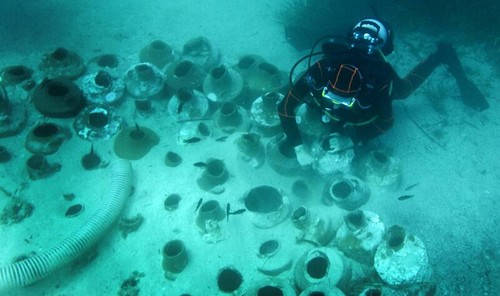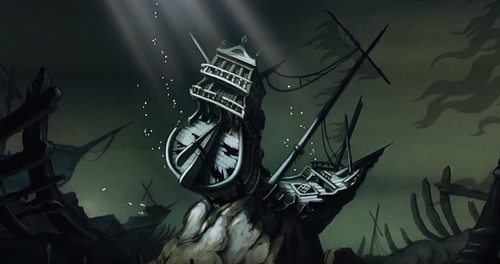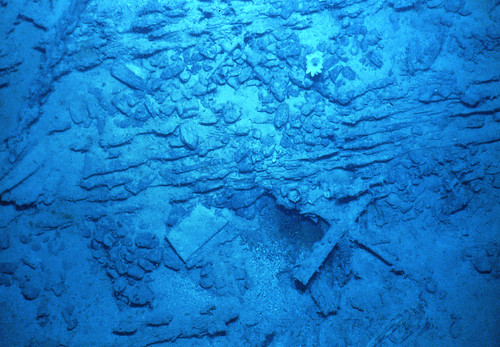
PREV ARTICLE
NEXT ARTICLE
FULL ISSUE
PREV FULL ISSUE
ON SHIPWRECK SALVAGE
On July 12, 2016, the Wall Street Journal published an article on the future of shipwreck salvage. Here's an excerpt. -Editor

Ancient Roman amphorae off the coast of the Southern France Unesco estimates that there are some three million shipwrecks scattered across the ocean floor. This means there is a vast trove of archaeological material awaiting discovery, all of it, fortunately, safe from destruction or theft by the criminal factions now operating on land. The technology needed for deep-sea exploration is advancing rapidly. What once seemed like science fiction will soon become a reality, with exploratory probes not only transmitting images but operating retrieval devices equipped to reveal artifacts and move them to the surface. Archaeologists have also begun using DNA analysis on wrecks in the Mediterranean, yielding information ranging from what onboard bowls once contained to the home port of the sunken ship. But only a tiny fraction of this material has been explored. For example, of the Archaeological Institute of America’s Fieldwork Opportunities Bulletin listings in Italy, only three involve underwater archaeology. And this in the nation estimated to have among the highest concentrations of archaeological sites in the world. If discovered relatively undisturbed, shipwrecks offer a tantalizing opportunity for archaeologists. They can yield remarkably detailed information about both the cargo and the presumed origins and destination of the vessel. They can also provide extraordinary insight into the geopolitics, economies and artistic inclinations of any given period of the ancient world. Archaeologists follow a rigorous set of procedures not just to retrieve objects but to preserve whatever information about them the site itself can disclose. In recent decades, a cottage industry of private exploration companies has emerged, lured by the promise of gold bullion and coins known to be in wrecks of trading vessels from the 16th century onward. Many of these are clustered along the eastern coastlines of North and South America. Such expeditions are rarer in bodies of water frequented in antiquity owing to our lack of information about lost treasure. But given the rate of progress in detecting and evaluating the contents of sunken vessels, we will doubtless soon see an increase in the pursuit of ancient shipwrecks. While the intentional looting and destruction of land-based sites is in the headlines today, another looming challenge to those seeking to safeguard the past awaits us underwater. And a fresh look at international accords governing the Law of the Sea as well as national laws is urgently needed. To read the complete article, see:
The author is a research affiliate for Princeton University’s Center for Arts and Cultural Policy Studies. Below is a less academic view
of shipwreck salvage followed by a comment from our resident expert Bob Evans, who helped find the wreck of the S.S. Central America and
recovered and curated its gold coins and bars. -Editor

A Hollywood Shipwreck: The Little Mermaid If I were asked to picture a shipwreck, a clear image would pop into my mind. I’ve never seen a shipwreck in real life; most of us haven’t. My imaginary shipwreck has a very clear source, though, one that was influential on my young mind. I'm imagining the shipwreck from Disney's The Little Mermaid. For me, the shipwreck that Ariel explores was iconic. But, if this is the vessel that defines shipwreck for me, how much of my idea of a sunken ship is pure Disney magic? Is there any truth to it? Kevin Crisman, the director of the Center for Maritime Archaeology and Conservation at Texas A&M University, immediately knew the genre of ship I was talking about: maritime archaeologists joke about “Hollywood shipwrecks” all the time, he says. One of the shipwrecks they “love to hate to watch" is the 18th-century ship that Nicolas Cage finds frozen in Arctic ice, at the beginning of National Treasure. (It’s very shortly blown to pieces with centuries-old gunpowder.) The Little Mermaid shipwreck was not one he had considered closely before, but Crisman graciously agreed to watch a few clips from the movie and give me his professional opinion about the wreck where Ariel famously finds a dinglehopper (also known as a fork). Now that I write about real shipwrecks, I wanted to know: What type of ship were we looking at? What made internal sense? And what was total fantasy? To read the complete article, see:

A Real Shipwreck Bob Evans writes: I am quite familiar with Hollywood Shipwrecks, or Hollywood Treasures. Attached is a photo of a real shipwreck. It wouldn't play on the big screen. Incredible states of preservation are typical of Hollywood Shipwrecks, as are grievous anachronisms, as pointed out in the article. I would point out that the interviewee can't help himself in getting in a dig about leaving artifacts for future archaeologists. "In situ preservation" is a myth, and a political agenda for some archaeologists. Some objects will survive, and I am not in favor of haphazard destruction of scientific information. But artifacts on shipwrecks, and the important information they hold, are in a constant state of marine peril, degrading even as I write this. They will be lost for all time if not properly excavated, conserved, and studied. Sooner is often better than later, though salvage probably should not be conducted by Hollywood mermaids. 
Wayne Homren, Editor The Numismatic Bibliomania Society is a non-profit organization promoting numismatic literature. See our web site at coinbooks.org. To submit items for publication in The E-Sylum, write to the Editor at this address: whomren@gmail.com To subscribe go to: https://my.binhost.com/lists/listinfo/esylum All Rights Reserved. NBS Home Page Contact the NBS webmaster 
|